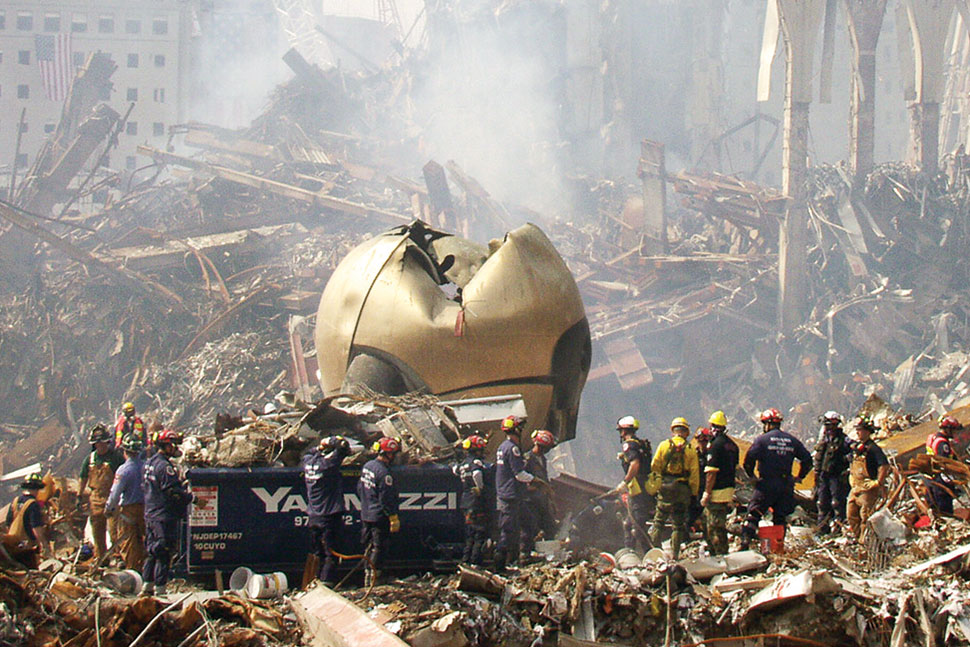
Following the September 11, 2001, terrorist attacks on the World Trade Center in New York City, many archivists and librarians wanted to help colleagues—particularly those working near Ground Zero—with recovery efforts. They just weren’t sure what that help would look like.
Kathleen D. Roe, chief of archival services at New York State Archives in Albany at the time and now retired, says her team was prepared to deal with wet or dusty records or damaged collections. “We pretty quickly found out that either collections were pretty much okay because they were in a safe building that didn’t get damaged by the attacks, or they were gone completely,” she says. “There was very little in between.”
Twenty-one libraries were confirmed destroyed in the World Trade Center. But a 2002 report by the Heritage Emergency National Task Force (HENTF), Cataclysm and Challenge: Impact of September 11, 2001, on Our Nation’s Cultural Heritage, puts that figure higher. “It is believed many more corporate libraries were destroyed, given the number of law and investment firms in the complex,” the study reads, also mentioning the records and archives of some 60 nonprofit organizations that had offices in the World Trade Center.
Among the 21 libraries destroyed were those of the American Merchant Marine Library Association, US Customs Service, Journal of Commerce, and Port Authority of New York and New Jersey, the agency that owned most of the World Trade Center’s 16-acre mixed-use campus at the time.
The loss of historic and cultural items from archival and corporate collections in and around the World Trade Center was staggering: paintings by David Hockney, Paul Klee, Roy Lichtenstein, and Pablo Picasso; letters written by Helen Keller; sculptures and tapestries by Alexander Calder, Joan Miró, Masayuki Nagare, Auguste Rodin, and James Rosati; 40,000 photographic negatives of US President John F. Kennedy by his personal photographer, Jacques Lowe; documents related to US trade dating back to the 1840s; and the Broadway Theatre Archive’s 35,000 photographs.
Librarian Betty L. Wagoner told American Libraries at the time (November 2001, p. 14) that the library she established for the nonprofit National Development and Research Institutes (NDRI)—which contained 5,000 items on substances abuse and HIV/AIDS—was gone. She said the library, located on the 16th floor of Tower Two, “was just reaching the point where it was actually quite useful.”
Port Authority spokesman Steve Coleman told the Associated Press in 2011, a decade after the disaster, that the agency had a “general idea” of which holdings were destroyed on the 67th floor of Tower One that day. Coleman named the Port Authority’s video and photo archives, board meeting minutes, and the 1921 charter agreement that established the agency among the lost items. (By contrast, the Pentagon in Arlington, Virginia, was able to save about 99% of its library’s book collection after American Airlines Flight 77 crashed into the west side of its building, according to HENTF’s report.)
Documenting the aftermath
After September 11, a priority for Roe and the New York State Archives was to locate colleagues in the historical records-holding community who worked in New York City’s Frozen Zone, the area below 14th Street in Lower Manhattan. Businesses were closed, and very few people had cellphones back then, Roe recalls. The first step was finding out if colleagues were alive, okay, and if they needed anything.
Roe says she was part of a group of archivists that convened in New York City two weeks after September 11. It became apparent to the group that help with recovery efforts wasn’t what was needed; assistance documenting the event, however, was.
“We’re right in the middle of this,” Roe recalls the group realizing. “We need to think about what stories need to survive this and intentionally see that those stories survive.”

From the group that met shortly after terrorist attacks, the World Trade Center Documentation Task Force (WTCDTF) was formed. As repositories across New York started documentation efforts, the task force served as a clearinghouse of information—identifying the most critical documentation issues, supporting organizations creating records and building collections, and encouraging individual and collaborative projects to preserve history. Roe chaired the task force along with Robert Morris of the National Archives’ Northeast Region.
To assess the landscape, WTCDTF surveyed 800 known historical records-collecting institutions in New York’s five boroughs, Long Island, and Orange, Putnam, and Westchester counties, to ask about their post–September 11 experiences and needs. More than 250 institutions responded, and the results enabled the task force to apply for a grant from the National Archives’ National Historical Publications and Records Commission to fund individual repositories’ documentation projects.
“For example, out on Long Island, there were a lot of really nice [documentation] projects done because so many of the firefighters and police and support staff for the recovery efforts were from there,” says Roe.
The task force and its members also guided the 9/11 Memory Project, which put archivists and librarians in direct contact with survivors and victims’ families. Project participants met with archivists to learn about options for preserving the memorabilia of deceased loved ones, including “heartbreaking answering machine messages” that were left the day of the attacks, says Roe.
She remembers the process was handled extremely delicately. Instructors were not at the front of the room giving PowerPoint presentations on how to archive, as can be common in genealogy and research workshops. Rather, archivists talked with small groups of 5–10 people in comfortable chairs, “just giving advice” on what families might want to do with certain items and making themselves available to the community.
We need to think about what stories need to survive this and intentionally see that those stories survive.—Kathleen D. Roe, retired chief of archival services at New York State Archives in Albany
The 9/11 Memory Project had a psychologist on its board, who suggested putting project materials online so people could look at it at their own pace, Roe says. The approach was, “Here’s what you have, here’s what’s important, and some day when you’re ready—if you want that person’s story to live on—here are some places you could give [the memorabilia] to,” she says.
“My staff cried, people attending cried, all of us did,” says Roe of the emotions that would surface at these meetings. “People really needed a very different approach than what librarians and archivists were used to doing.”
Roe herself lost a friend in the Twin Towers. She also knew someone who attended 20 funerals after September 11. “Twenty years later, I cry,” she says.
Planning for the next disaster
Because September 11 was “so tragically unique,” says HENTF coordinator Lori Foley, it is seen in archival circles as the disaster that was impossible to plan for.
“We can’t fully prepare for a large-scale hostile act, but we can—and should—prepare for other hazards that can impact our institutions,” she says.
In 2004, Heritage Preservation (HP) partnered with the Institute of Museum and Library Services (IMLS) on a comprehensive survey of collecting institutions across the US: The Heritage Health Index Report on the State of America’s Collections. The survey found that only 32% of collecting institutions had a disaster plan that included collections, with just 20% having a plan and staff trained to carry it out. When HP, IMLS, and the National Endowment for the Humanities measured these figures again in 2014, they saw some progress, with the numbers rising to 42% and 24%, respectively.
“Emergency preparedness efforts in the cultural community have slowly been improving since 2001,” says Foley. “Following a natural disaster, an uptick in emergency planning often occurs.” On the other hand, she says, when disasters haven’t occurred for some period of time—or strike far from home—“interest in preparedness wanes and complacency sets in.”

To develop skills for disaster preparedness, Foley recommends that cultural stewards and emergency managers look to HENTF’s Heritage Emergency and Respond Training program, which enables participants to gain experience in damage assessment, emergency documentation, rehousing and storage, and other processes. She also suggests the Council of State Archivists’ Pocket Response Plan, a handheld, two-sided document that includes contact information for staffers, first responders, utilities, and vendors, and an emergency response checklist of actions that organizations should take in the first 24 to 72 hours.
“Life safety is the highest priority—staff, volunteers, patrons, guests,” says Foley. “Has everyone evacuated the building safely? Is everyone accounted for, including those who may be out of the office that day?”
Yet disaster response isn’t just for cultural organizations. When September 11 struck, Foley was working at the Northeast Document Conservation Center as a field service representative, providing telephone disaster assistance to institutions and individuals. “Within a week, I started receiving calls from individuals who returned to their Lower Manhattan apartments to find precious items—framed photographs, a scrapbook, a family Bible—coated in dust from the collapse of the Towers. They wanted to know how to safely remove the abrasive dust from their cherished belongings,” she says. “Following Hurricane Katrina, I took similar calls from individuals who had lost nearly everything but wanted to know how to save a beloved photo that was muddied and torn.”
Foley believes recovering our cultural assets is essentially what drives a place to get back on its feet. “When disaster strikes a community, recovery of these very institutions is vital for the economic, social, artistic, religious, and civic life of that community,” she says. “If these institutions don’t recover, the community never fully recovers.”
Still collecting
It remains difficult to get a complete picture of the treasures lost on September 11, as well as which agencies tried to build back new collections.
Wagoner of NDRI was offered items to restock her collection by those in the library community who had double runs, she told American Libraries in 2001, but NDRI would disband in 2019. The organization is among a handful that had libraries in the World Trade Center and have since shuttered for reasons unrelated to September 11, including the US Customs Service (reorganized in 2003) and law firm Thacher Proffitt and Wood (dissolved in 2008).
The Port Authority of New York and New Jersey has not rebuilt a public archive but is working to digitize photos that have been shared with the agency from personal collections. In recent years, the Port Authority has been linked to September 11 and archives in another powerful way: The agency ran a program from 2010 to 2016 that gave away more than 2,600 artifacts collected from the World Trade Center wreckage to fire and police departments, museums, and municipalities in all 50 states and several countries around the world. “The project has definitely created a network that will continue the memory of 9/11 through history,” archivist and program manager Amy Passiak told PBS NewsHour Weekend in 2016.
Though stakeholders of the 9/11 Memory Project no longer meet—they last debriefed in 2007 at the end of the project’s grant cycle—Roe says collection development and maintenance of this and other September 11 archives is not over. The Metropolitan Archivists Round Table has taken on the memory project, and, for the 20th anniversary of September 11, New York State Archives’ Documentary Heritage Program has placed a grant emphasis on World Trade Center documentation.
Twenty years on, Roe and others in the archival community are finding that people who have held on to September 11 documents are now at the age of retirement and submitting items to repositories. The work is continuing, she says, “not in obvious, glitzy ways but in very compelling and important ways, so that there will be a really solid documentation of the human experience of 9/11 and the impact it had on our lives.”
“It’s not done,” says Roe. “It won’t be done until the last survivor passes, until the last victim family member is gone, and that’s a long, long time.”
Among the Libraries and Archives Destroyed on September 11
– American Merchant Marine Library Association
– The library of Aon Corporation
– The library of the Council of State Governments
– The library of Fiduciary Trust Company International
– The library of Guy Carpenter and Company
– The library of Hill Betts and Nash
– The library of the Journal of Commerce
– The library of Morgan Stanley (Tower Two)
– The library of the National Development and Research Institutes
– Nearly the complete archives of the Port Authority of New York and New Jersey
– The library of Serko and Simon
– The library of Sidley Austin Brown and Wood
– The library of Thacher Proffitt and Wood
– Ferdinand Gallozzi Library of the US Customs Service
Some of the Cultural Items Lost
– Paintings by David Hockney, Paul Klee, Roy Lichtenstein, and Pablo Picasso
– Sculptures and tapestry by Auguste Rodin, Alexander Calder, Joan Miró, Masayuki Nagare, and James Rosati
– Letters written by Helen Keller
– About 40,000 photographic negatives of US President John F. Kennedy by his personal photographer, Jacques Lowe
– Documents related to US trade dating back to the 1840s
– Broadway Theatre Archive’s 35,000 photographs
– About 900,000 artifacts (excavated from an archeological site in 1991) from the 19th-century Lower Manhattan neighborhood Five Points that were stored at 6 World Trade Center
– Family records and heirlooms stored in safety deposit boxes and vaults of World Trade Center banks, including a collection of 25 antique handwoven rugs that had been passed down through generations of Muslim families from the Middle East, North Africa, and Southeast Asia
– About 1% of the Pentagon’s book collection
Sources: American Libraries reporting (2001–2002); “Mystery Surrounds Loss of Records, Art on 9/11” (Associated Press, September 11, 2011); Cataclysm and Challenge: Impact of September 11, 2001, on Our Nation’s Culture Heritage, a report by Heritage Preservation on behalf of the Heritage Emergency National Task Force (2002).


